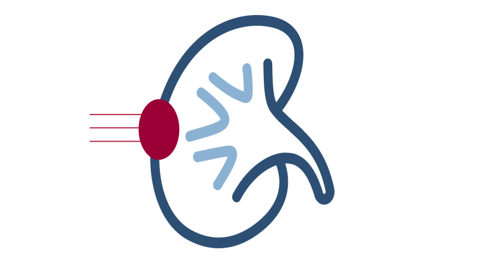Cryoablation
Tumors can be treated with extreme heat or cold. We call this thermal ablation. The extreme temperature will vaporize the cancer cells. Your body will clean up the cells after the ablation. The treatment leaves a scar in the area receiving the treatment.
What is cryoablation?
If you receive a cryoablation, your tumor cells with be vaporized by extreme cold temperatures. Cryoablation is an option for several tumor types in the kidneys, lungs, breast, prostate, abdominal cavity, soft tissue or bones. We can use cryoablation to shrink a large tumor, or to treat pain symptoms. Whether cryoablation is an option for you will be discussed during a multidisciplinary team meeting with all specialists involved in your treatment. Your practicing physician will discuss the results of this meeting with you.

Illustration cryoablation
What will happen before your cryoablation?
If you qualify for ablation treatment, you will be referred to our Interventional Radiology Image Guided Oncological Treatment clinic. You will receive more information about the procedure. You will have an appointment for preoperative screening later that day. Your anesthesiologist will decide whether you are in the right shape for the procedure. If you are, you will be placed on a waitlist.
Cryoablation: how does it work?
Your radiologist will insert one or more needles into the tumor, guided by an ultrasound, MRI or CT for imaging. He or she will insert the needle through the skin. The ablation will most likely be done while you are under general anesthesia. Some people may benefit from an epidural (local anesthetic) or a sedative. Your anesthesiologist will discuss your options with you at the clinic.
What are the side effects?
Risks are inherent to all types of treatment. Any hospital admission carries a small risk of thrombosis (blood clot in a blood vessel) or infection (pneumonia or urinary tract infection). The procedure may cause bleeding, infection, or damage to the organ receiving the treatment, its surrounding structures, or the area through which the needle is inserted. Some examples are: kidney dysfunction, urinary leakage after a kidney ablation, or lung collapse after a lung ablation through the pulmonary cavity.
What to expect after the treatment?
Once you have recovered sufficiently, you can go home. Most people can leave the hospital on the day after the procedure.
After your ablation you may notice several small, visible cuts. The wound is much bigger on the inside of your body, and your body will have to work hard to heal. The discomfort you may experience will depend on the size and location of your tumor. You may experience the following symptoms over the first weeks after the treatment:
- Fatigue
- Pain around the treated area
- Nausea
- Flu symptoms
- Fever up to 38.5 degrees Celsius.
You may also experience more specific problems in the organ that has received the treatment, or the area through which the needle was inserted. Some examples:
- Coughing with or without blood (for lung ablations, or ablations through the pulmonary cavity)
- Blood in the urine (for kidney or prostate ablations)
- Numbness or pain on the skin.
 nl
nl
 Nederlands (Nederland)
Nederlands (Nederland)
 English (United States)
English (United States)